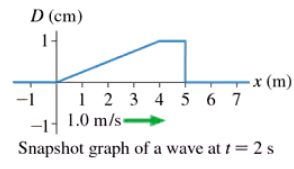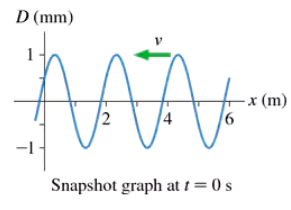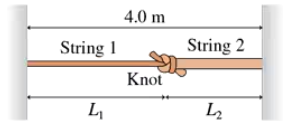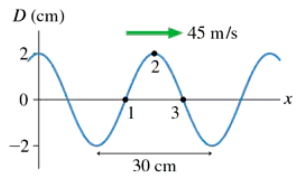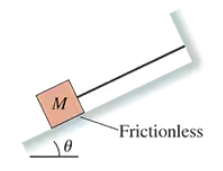 Back
BackProblem 2
The wave speed on a string under tension is 200 m/s. What is the speed if the tension is halved?
Problem 4
Draw the history graph D(x = 4.0 m, t) at x = 4.0 m for the wave shown in FIGURE EX16.4.
Problem 8
FIGURE EX16.8 is a picture at t = 0 s of the particles in a medium as a longitudinal wave is passing through. The equilibrium spacing between the particles is 1.0 cm. Draw the snapshot graph D(x, t = 0 s) of this wave at t = 0 s.
Problem 15
Show that the displacement D(x,t) = cx² + dt², where c and d are constants, is a solution to the wave equation. Then find an expression in terms of c and d for the wave speed.
- Show that the displacement D(x,t) = ln(ax + bt), where a and b are constants, is a solution to the wave equation. Then find an expression in terms of a and b for the wave speed.
Problem 16
Problem 17a
What is the frequency of an electromagnetic wave that has the same wavelength as a 2.5 kHz sound wave in water?
Problem 22
A hammer taps on the end of a 4.00-m-long metal bar at room temperature. A microphone at the other end of the bar picks up two pulses of sound, one that travels through the metal and one that travels through the air. The pulses are separated in time by 9.00 ms. What is the speed of sound in this metal?
Problem 23
A 15-cm-long aluminum tank is filled with ethyl alcohol. A high-frequency ultrasound wave travels horizontally through one wall of the tank and then through the alcohol. There are 275 times more cycles of the wave in the alcohol than in the aluminum wall. How thick is the wall of the tank?
Problem 27
What is the speed of sound in air (a) on a cold winter day in Minnesota when the temperature is -25°F, and (b) on a hot summer day in Death Valley when the temperature is 125°F?
Problem 30
A spherical wave with a wavelength of 2.0 m is emitted from the origin. At one instant of time, the phase at r = 4.0 m is π rad. At that instant, what is the phase at r = 3.5 m and at r = 4.5 m?
Problem 31a
A sound source is located somewhere along the x-axis. Experiments show that the same wave front simultaneously reaches listeners at x = -7.0 m and x = +3.0 m. What is the x-coordinate of the source?
Problem 32
A loudspeaker at the origin emits a 120 Hz tone on a day when the speed of sound is 340 m/s. The phase difference between two points on the x-axis is 5.5 rad. What is the distance between these two points?
Problem 33
The intensity of electromagnetic waves from the sun is 1.4 kW/m² just above the earth's atmosphere. Eighty percent of this reaches the surface at noon on a clear summer day. Suppose you think of your back as a 30 cm x 50 cm rectangle. How many joules of solar energy fall on your back as you work on your tan for 1.0 h?
Problem 34
A sound wave with intensity 2.0 x 10-3 W/m2 is perceived to be modestly loud. Your eardrum is 6.0 mm in diameter. How much energy will be transferred to your eardrum while listening to this sound for 1.0 min?
Problem 36a
A concert loudspeaker suspended high above the ground emits 35 W of sound power. A small microphone with a 1.0 cm² area is 50 m from the speaker. What is the sound intensity at the position of the microphone?
Problem 38a
What are the sound intensity levels for sound waves of intensity 3.0 x 10-6 W/m2?
Problem 42a
A friend of yours is loudly singing a single note at 400 Hz while racing toward you at 25.0 m/s on a day when the speed of sound is 340 m/s. What frequency do you hear?
Problem 44
A bat locates insects by emitting ultrasonic 'chirps' and then listening for echoes from the bugs. Suppose a bat chirp has a frequency of 25 kHz. How fast would the bat have to fly, and in what direction, for you to just barely be able to hear the chirp at 20 kHz?
Problem 45c
FIGURE P16.45 is a snapshot graph at t = 0 s of a 5.0 Hz wave traveling to the left. Write the displacement equation for this wave.
Problem 47
String 1 in FIGURE P16.47 has linear density 2.0 g/m and string 2 has linear density. A student sends pulses in both directions by quickly pulling up on the knot, then releasing it. What should the string lengths L₁ and L₂ be if the pulses are to reach the ends of the strings simultaneously?
Problem 49
A helium-neon laser beam has a wavelength in air of 633 nm. It takes 1.38 ns for the light to travel through 30 cm of an unknown liquid. What is the wavelength of the laser beam in the liquid?
Problem 50
Earthquakes are essentially sound waves—called seismic waves—traveling through the earth. Because the earth is solid, it can support both longitudinal and transverse seismic waves. The speed of longitudinal waves, called P waves, is 8000 m/s. Transverse waves, called S waves, travel at a slower 4500 m/s. A seismograph records the two waves from a distant earthquake. If the S wave arrives 2.0 min after the P wave, how far away was the earthquake? You can assume that the waves travel in straight lines, although actual seismic waves follow more complex routes.
Problem 51
One cue your hearing system uses to localize a sound (i.e., to tell where a sound is coming from) is the slight difference in the arrival times of the sound at your ears. Your ears are spaced approximately 20 cm apart. Consider a sound source 5.0 m from the center of your head along a line 45° to your right. What is the difference in arrival times? Give your answer in microseconds. Hint: You are looking for the difference between two numbers that are nearly the same. What does this near equality imply about the necessary precision during intermediate stages of the calculation?
Problem 53
A 20.0-cm-long, 10.0-cm-diameter cylinder with a piston at one end contains 1.34 kg of an unknown liquid. Using the piston to compress the length of the liquid by 1.00 mm increases the pressure by 41.0 atm. What is the speed of sound in the liquid?
Problem 54b
A sound wave is described by , where is in and is in . Along which axis is the air oscillating?
Problem 56c
A wave on a string is described by , where is in and in . The linear density of the string is . What are The maximum speed of a point on the string?
Problem 57
FIGURE P16.57 shows a snapshot graph of a wave traveling to the right along a string at 45 m/s. At this instant, what is the velocity of points 1, 2, and 3 on the string?
Problem 59
The string in FIGURE P16.59 has linear density μ. Find an expression in terms of M, μ, and θ for the speed of waves on the string.
Problem 62
A string that is under 50.0 N of tension has linear density 5.0 g/m. A sinusoidal wave with amplitude 3.0 cm and wavelength 2.0 m travels along the string. What is the maximum speed of a particle on the string?
Problem 65
A 1000 Hz sound wave traveling through 20°C air causes the pressure to oscillate around atmospheric pressure by ±0.050%. What is the maximum speed of an oscillating air molecule? Give your answer in mm/s.

